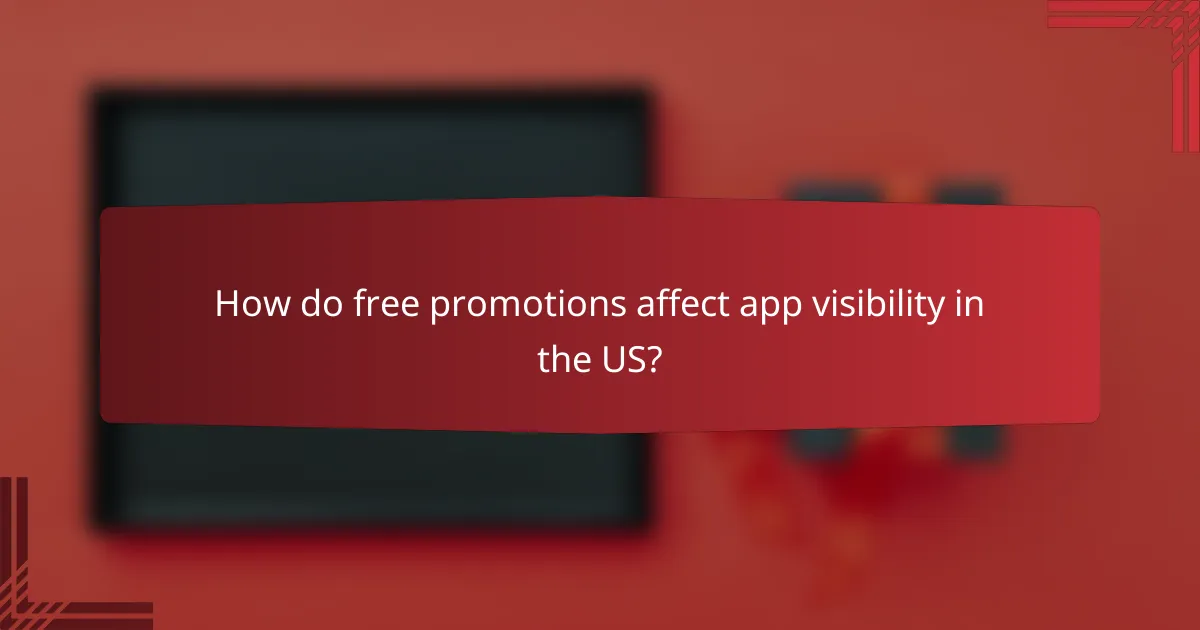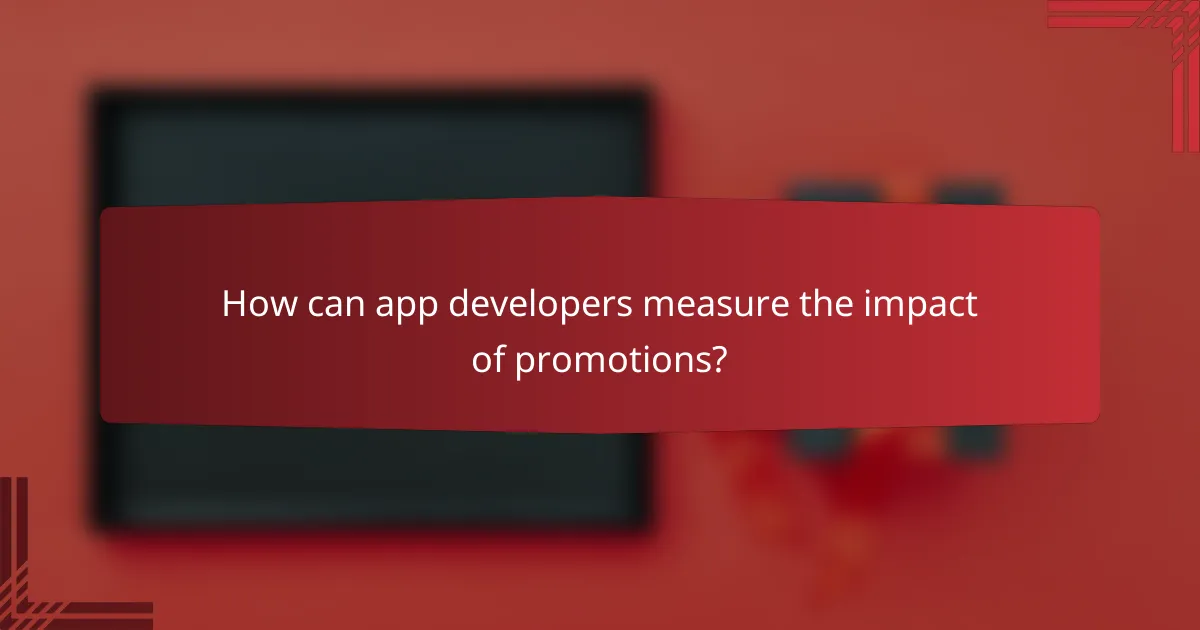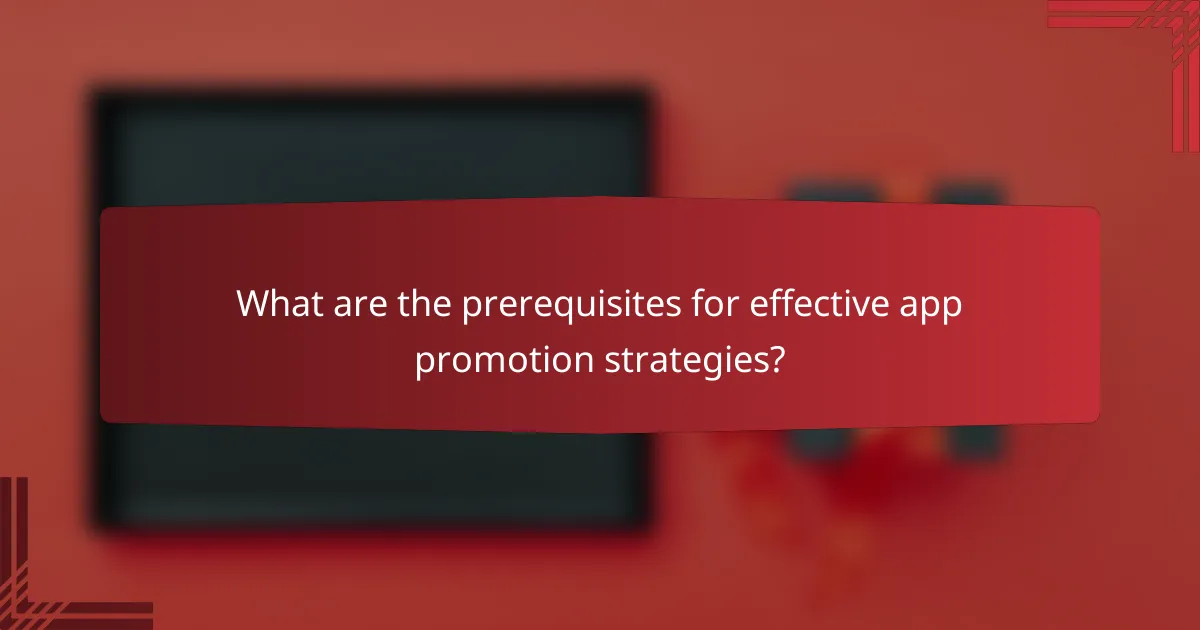The impact of free versus paid promotions on app visibility is a crucial consideration for developers aiming to maximize their reach. While free promotions can boost organic downloads and user engagement, they often fall short in terms of audience reach compared to paid strategies. Paid promotions, on the other hand, offer immediate access to a broader audience, leading to increased downloads and enhanced brand recognition.

How do free promotions affect app visibility in the US?
Free promotions can significantly enhance app visibility in the US by increasing organic downloads and user engagement. However, they often have limitations in reach compared to paid promotions, which can provide a more immediate and extensive audience exposure.
Increased organic downloads
Free promotions can lead to a surge in organic downloads as users discover the app through various channels, such as social media, blogs, or app store features. This method often relies on word-of-mouth and community sharing, which can create a snowball effect, leading to more downloads over time.
For instance, offering a limited-time free trial or a promotional event can attract users who might not have considered the app otherwise. This strategy can be particularly effective for niche apps that cater to specific interests or needs.
Higher user engagement
When users download an app through free promotions, they are often more engaged, as they feel they are getting value without financial commitment. This can lead to higher retention rates and increased usage, as users explore the app’s features without the pressure of a purchase.
Engagement can be further enhanced by incorporating feedback mechanisms, such as in-app surveys or community forums, allowing users to feel involved in the app’s development. This interaction can foster loyalty and encourage users to recommend the app to others.
Limited reach compared to paid promotions
While free promotions can boost visibility, their reach is typically more limited than that of paid promotions. Paid advertising can target specific demographics and reach a broader audience quickly, which is often essential for new app launches or competitive markets.
For example, a well-placed ad on social media or search engines can generate immediate traffic and downloads, whereas free promotions may take longer to gain traction. Developers should consider a balanced approach, utilizing both free and paid strategies to maximize visibility and downloads.

What are the benefits of paid promotions for app visibility?
Paid promotions significantly enhance app visibility by allowing developers to reach a broader audience quickly and effectively. These strategies often lead to increased downloads, higher engagement rates, and improved brand recognition compared to free methods.
Targeted audience reach
Paid promotions enable developers to target specific demographics, interests, and behaviors, ensuring that the app is shown to users most likely to engage with it. For instance, platforms like Facebook and Google Ads allow for detailed targeting options, which can lead to higher conversion rates.
By focusing on a defined audience, app developers can allocate their budgets more efficiently, maximizing the return on investment. This targeted approach often results in a more engaged user base, as the app is presented to individuals who are genuinely interested in its features.
Enhanced brand awareness
Investing in paid promotions can significantly boost brand awareness, as ads are displayed across various platforms, reaching potential users who may not have discovered the app otherwise. This increased visibility helps establish the app’s presence in a crowded market.
Consistent exposure through paid channels can lead to higher brand recall, making users more likely to download the app when they see it in the app store. Over time, this can create a loyal user base that recognizes and trusts the brand.
Immediate visibility boost
One of the primary advantages of paid promotions is the immediate visibility they provide. Unlike organic methods, which can take time to yield results, paid ads can place an app at the top of search results or featured sections almost instantly.
This immediate boost can be crucial during product launches or promotional events, where developers need to capture user interest quickly. However, it’s important to monitor the performance of these campaigns regularly to ensure they are generating the desired outcomes and adjust strategies as needed.

Which platforms offer effective paid promotion options?
Several platforms provide effective paid promotion options that can significantly enhance app visibility. Key players include Facebook, Google, and Instagram, each offering unique features and targeting capabilities to reach specific audiences.
Facebook Ads
Facebook Ads allow app developers to target users based on demographics, interests, and behaviors. Advertisers can choose from various ad formats, including image, video, and carousel ads, to showcase their app effectively.
When setting up a campaign, it’s crucial to define your target audience clearly and set a budget that aligns with your marketing goals. A common strategy is to start with a daily budget of around $5 to $10 to test ad performance before scaling up.
Google Ads
Google Ads offers a robust platform for promoting apps through search and display networks. Advertisers can create app install campaigns that drive downloads directly from search results or across millions of websites.
Using keywords relevant to your app is essential for maximizing visibility. A recommended approach is to focus on long-tail keywords, which often have lower competition and can yield higher conversion rates.
Instagram Ads
Instagram Ads, integrated with Facebook’s advertising system, are visually driven and ideal for showcasing apps through engaging imagery and videos. The platform supports various ad formats, including Stories and feed ads, which can capture users’ attention effectively.
To optimize your Instagram ad campaigns, consider using eye-catching visuals and clear calls to action. Starting with a budget similar to Facebook Ads can help gauge performance before making larger investments.

What are the costs associated with free vs. paid promotions?
The costs associated with free and paid promotions can significantly impact an app’s visibility. Free promotions typically incur no direct financial costs, while paid promotions require a budget allocation that varies based on the chosen strategy and platform.
Free promotions have no direct costs
Free promotions involve methods such as social media sharing, organic search optimization, and leveraging app store features. These strategies do not require monetary investment, making them accessible for developers with limited budgets.
However, while there are no direct costs, free promotions often demand significant time and effort to execute effectively. Developers must engage with their audience and create compelling content to enhance visibility.
Paid promotions require budget allocation
Paid promotions necessitate a financial commitment, which can vary widely based on the platform and campaign goals. Common methods include pay-per-click (PPC) advertising, social media ads, and influencer partnerships.
Setting a budget is crucial, as costs can range from a few dollars to thousands per campaign. Developers should consider their target audience and expected return on investment (ROI) when determining how much to spend on promotions.
Cost-per-click vs. cost-per-install
Cost-per-click (CPC) and cost-per-install (CPI) are two common pricing models in paid promotions. CPC charges advertisers each time a user clicks on their ad, while CPI charges for each installation of the app resulting from the ad.
Choosing between these models depends on marketing goals. If the objective is to drive traffic to the app store, CPC may be more suitable. Conversely, if the focus is on acquiring users, CPI can provide a clearer measure of success. Understanding these costs helps developers optimize their promotional strategies effectively.

How can app developers measure the impact of promotions?
App developers can measure the impact of promotions by analyzing various performance metrics and user behavior data. This involves using analytics tools, tracking user acquisition metrics, and evaluating the return on investment (ROI) of different promotional strategies.
Using analytics tools
Analytics tools are essential for app developers to track user engagement, downloads, and retention rates. Popular tools like Google Analytics, Firebase, and Mixpanel provide insights into how users interact with the app after a promotion. By setting up specific events and conversion goals, developers can pinpoint which promotions drive the most valuable user actions.
Developers should regularly review dashboards and reports generated by these tools to identify trends and patterns. This data can inform future promotional strategies and help optimize marketing efforts.
Tracking user acquisition metrics
User acquisition metrics, such as cost per install (CPI) and lifetime value (LTV), are crucial for understanding the effectiveness of promotions. By calculating CPI, developers can assess how much they are spending to gain new users through paid promotions compared to organic growth from free promotions.
Additionally, tracking LTV helps developers understand the long-term value of users acquired through different channels. This comparison allows for informed decisions on whether to invest more in paid promotions or focus on organic methods.
Evaluating return on investment
Evaluating ROI is vital for determining the financial success of promotional campaigns. Developers should calculate ROI by comparing the revenue generated from new users against the costs incurred during the promotion. A positive ROI indicates that the promotion was successful.
To effectively evaluate ROI, developers can use a simple formula: (Revenue from new users – Cost of promotion) / Cost of promotion. This calculation helps in assessing which promotional strategies yield the best financial returns and guides future marketing investments.

What are the prerequisites for effective app promotion strategies?
To implement effective app promotion strategies, understanding your target audience and selecting the right promotional channels are crucial. These factors determine how well your app will be received and its visibility in a competitive market.
Understanding target audience
Identifying your target audience is essential for tailoring your app promotion strategies. Consider demographics such as age, gender, location, and interests, as these will influence how you market your app and which platforms to use.
Utilize tools like surveys, social media analytics, and app store data to gather insights about potential users. This information can help you create user personas that guide your promotional efforts, ensuring your messaging resonates with the right people.
When promoting your app, focus on the channels where your target audience is most active. For instance, younger users may prefer platforms like TikTok or Instagram, while older demographics might engage more on Facebook. Aligning your promotional strategies with audience preferences can significantly enhance visibility and engagement.


